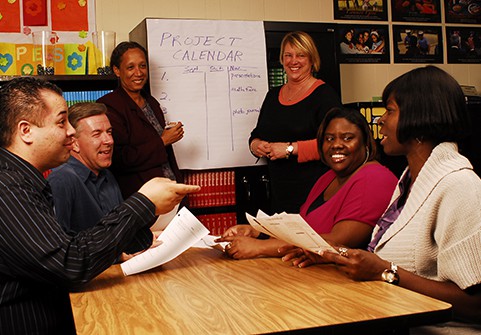Situated Learning: What Good EdTech Leaders Never Stop Studying

By Jason Ribeiro
District education technology leaders often bring a wealth of experience to the position. Be it a combination of time spent in the classroom, administration (or more commonly), working in Information Technology (IT) services, these leaders are often well-versed in most things education and technology. But how many of our senior officials can say the same about their knowledge of leadership? Beyond work experience, do our most trusted leaders receive the proper leadership training to guide interdisciplinary teams through often costly, high-stakes technology implementations? If so, situated learning should be a term they are well acquainted with. For those who are not, this adult learning theory could help redefine both your practice and work environment in the future.
Situated learning is the practice of learning knowledge and skills in contexts that mirror the way the knowledge will be used in ‘real life.’ Champions of this style of learning and leading believe that education is a process of forming meaning through experience. In the bureaucratic structure of school district governance, this is often a rarity.
However, great education technology leaders allow knowledge to be constructed through both discovery and active problem solving. How do they do this? They acknowledge that deep and meaningful learning can only occur when a context has been created for informal learning to happen with their teams. And the kicker is…these experiences need to take place in a social environment. Not behind a desk. Not in an email chain. People need to interact with one another for this type of workplace learning to occur.
Food for thought: Over 70 percent of workplace learning is informal, despite the millions of dollars organizations (i.e. school districts) commit to formal training programs for their employees (i.e. teachers, consultants, superintendents, principals, etc.).
So what do we call these magical informal, social environments? Communities of practice or CoPs. They are:
- Naturally occurring
- Comprised of an evolving collection of people
- Allowing people to engage together in particular kinds of activity
- Providing people with the opportunity to develop and share ways of doing things effectively
These groups typically have small numbers of members but their impact on knowledge creation and strategic planning can be quite powerful. Even newcomers who are hesitant to join these communities (and begin on the periphery) often move toward full participation as deeply engaged learners. Free from coercive pressures to attend sessions, learners feel comfortable engaging in authentic, shared dialogue about practical issues and concerns.
When applying situated learning to school district technology leadership teams, education leaders need to understand that their working environment has undergone rapid changes in the last five years.
Historically, educational technology was seen as an addition to the learning experience for students, not an inseparable component. With this extraordinary shift in people’s professional and personal lives, it is important that this real-world context is not forgotten. Another enormous shift in the school district system has been the increasing role of IT staff and the growing expectation that academic and IT partners work together in the procurement and implementation of educational technology. This is unprecedented and district leaders are struggling to bridge the gap between the two groups and help them understand the combined challenges of both the system network and the classroom.
Part of the problem in trying to create a more collaborative and trusting environment for team members is that large-size school districts are heavily managed, governed and resistant to change. It should come as no surprise that most of the instances of high-capacity teamwork and innovation in educational technology implementation are emerging from smaller districts, individual schools, or even micro-schools. Clearly the complex organizational and operational challenges facing district leaders are not small matters.
Communities of practice could help build trust and generate new knowledge in this uncertain time in educational leadership. While CoPs are often described as a naturally occurring process that underlies all knowledge and learning, new thinking is emerging that indicates CoPs can indeed be created and fostered. Perhaps this is the first step a Chief Information Officer needs to take in order to move their teams beyond their silos so they can begin to work more effectively and collaboratively.
For more check out:
- Preparing Leaders for Deeper Learning
- 10 Next Steps for EdLeaders: The Advanced Course
- EdLeaders as Lead Communicators
Jason Ribeiro is a Ph.D. student at the University of Calgary in Alberta, Canada specializing in Educational Leadership. Follow Jason on Twitter at @jason_ribeiro.


0 Comments
Leave a Comment
Your email address will not be published. All fields are required.